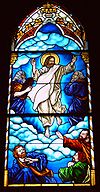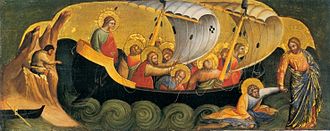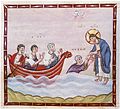- Jesus' walk on water
-
This article is about the miracle of Jesus walking on water in Christianity, for other uses see Walk on Water.
Jesus' walks on water, or Jesus walking on water, is one of the miracles of Jesus in the Gospels. Accounts of the miracle appear in three Gospels: Matthew 14:22-33, Mark 6:45-52 and John 6:16-21.
According to the biblical narratives, Jesus sent the disciples in a ship, ahead of him, to the other side, but when they were "in the midst" of the Sea of Galilee, they saw Jesus "walking on the sea" to meet them. The narrative states that the disciples were frightened at first, thinking they were seeing a spirit, but when Jesus revealed himself and climbed into the boat, they were reassured.[1][2] According to Matthew, Peter also walked out onto the water towards Jesus, but when Peter saw the wind and the waves, he became afraid and began to sink, and Jesus rescued him.[3]
Contents
Christian interpretation
The walking on the sea miracle has specific interpretations within Christian teachings. Merrill Tenney states that the incident centered on the relationship of Jesus with his apostles, rather than their peril or the miracle itself.[4] Similarly, authors Dwight Pentecost and John Danilson argue that this miracle was deliberately designed by Jesus to instruct his apostles and increase their faith.[5]
Pentecost and Danilson note that according to the Gospel of John (John 6:19) the apostles had only been able to row slightly over three miles after several hours as they were buffeted by the waves and the [wind] storm. However, although the storm had prohibited them from fulfilling the command of Jesus, they did not give up and continued to exert themselves, straining at the oars (Mark 6:48).
In the pre-dawn night as Christ walked towards them, they realized that "the sea that had impeded their movement was no obstacle to Christ, and all that they feared brought no fear to Him."[6]
The apostle Peter initially showed great faith by walking on the water towards Jesus, but as he walked, fear grasped him as he began to sink, and he cried, "Lord, save me." Immediately Jesus reached out his hand and caught him, saying: "O thou of little faith, wherefore didst thou doubt?"[7] Here Jesus indicated that the temporary doubt in the power of Christ was the source of Peter's sinking.[8]
Only after Christ had brought Peter back to the boat, the wind died down (Matthew 14:32). At the end of the incident, the response of the apostles was to cry: "Truly you are the Son of God". Pentecost and Danilson thus suggest that the miracle was designed to teach the apostles that when encountering obstacles, they need to rely on their faith in Christ, first and foremost.[9]
Other interpretations
Skeptics contend that a natural means of support such as a sand bar may have existed or that the Gospel accounts may be a legend. There is also a suggestion that Jesus performed the miracle by skating or walking on surface ice on the lake, formed by a freak cold spell. [10][11] However, author Dawn Wilhelm dismisses the need for theories about reefs or surface ice, and states that if one believes the Gospels at all, one also believes that Jesus had the power to overcome the forces of nature in any case.[12]
R.T. France states that the writers of these Gospels go out of their way to note that the boat was a long way from the shore to remove doubts for believers in the New Testament that Jesus was walking on a reef or sand bar, and that the incident must have seemed very impressive to fishermen who were used to the lake. And that the portrayal of Peter sinking is intended as a confirmation of the depth of the water, and no other means of support.[13]
The word 'ἐπὶ' in the original Greek could also be used as 'toward' instead of upon,[14][15] implying that Jesus walked toward the water instead of upon the water. Mark and John allow for this ambiguity, but the account in Matthew of Peter's sinking makes this translation implausible for that account.
Gallery of art
-
François Boucher Cathédrale Saint-Louis (1766) Versailles
See also
- Ministry of Jesus
- Miracles of Jesus
- Parables of Jesus
- Water striders that walk on water and Basilisks that run
Notes
- ^ John 6:16–21
- ^ Mark 6:45–52
- ^ Matthew 14:22–33
- ^ Merrill Chapin Tenney 1997 John: Gospel of Belief ISBN 0802843514 page 114
- ^ J. Dwight Pentecost; John Danilson (photography) (2000). "The words and works of Jesus Christ". Zondervan. pp. 234-235. ISBN 0310309409. http://books.google.com/books?id=bh3M_AfgXZAC&lpg=PA234&pg=PA234#v=onepage&f=false. Retrieved 2011-10-04.
- ^ Pentecost - page 234
- ^ Matthew 14:30–31
- ^ Pentecost - page 235
- ^ Pentecost - page 235
- ^ BBC.co.uk
- ^ FSU.edu
- ^ Dawn Ottoni Wilhelm, 2008 Preaching the Gospel of Mark ISBN 0664229212 page 115
- ^ R. T. France 2007 The Gospel of Matthew ISBN 080282501X page 567
- ^ Scripturetext.com
- ^ Searchforgodsword.org
Miracles of Jesus Cures Bleeding woman · Blind man of Bethsaida · Blind at birth · Blind near Jericho · Blind men in Galilee · Centurion's servant · Jesus cleansing a leper · Cleansing ten lepers · Deaf mute of Decapolis · Dropsy · Gennesaret healings · Hunched woman · Mother of Peter's wife · Paralytic at Bethesda · Paralytic at Capernaum · Royal official's son · Servant's ear · Withered hand

Exorcisms Raising the dead Young man from Nain · Daughter of Jairus · Raising of Lazarus
Control of nature Catch of fish · Coin in the fish's mouth · Feeding the multitude · Fig tree cursed · Marriage at Cana · Storm calmed · Transfiguration · Walking on water
Christianity Portal Jesus' walk on waterPreceded by
Feeding the Multitudes
Miracles of JesusNew Testament
EventsSucceeded by
Blind Man of Bethsaida
Miracles of JesusCategories:- Biblical phrases
- Christian miracle narrative
- Miracles attributed to Jesus
- Water and religion
Wikimedia Foundation. 2010.






